Economic Factors and Decision Making in Malaysia's Hospitality
VerifiedAdded on 2023/06/13
|22
|4700
|382
Report
AI Summary
This report provides an overview of Malaysia's economic condition, focusing on its implications for the tourism and hospitality industry. It analyzes factors such as GDP growth, interest rates, population growth, and capital accumulation to identify opportunities for development. The role of the Malaysian government in influencing economic elements like GDP, interest rates, and foreign debt is examined. Furthermore, the report discusses strategies for tourism development, including infrastructural improvements, economic incentives, and marketing efforts. It also highlights the potential for business development in East Malaysia and concludes with recommendations for enhancing the hospitality sector. Desklib provides students with access to similar past papers and solved assignments for further study.
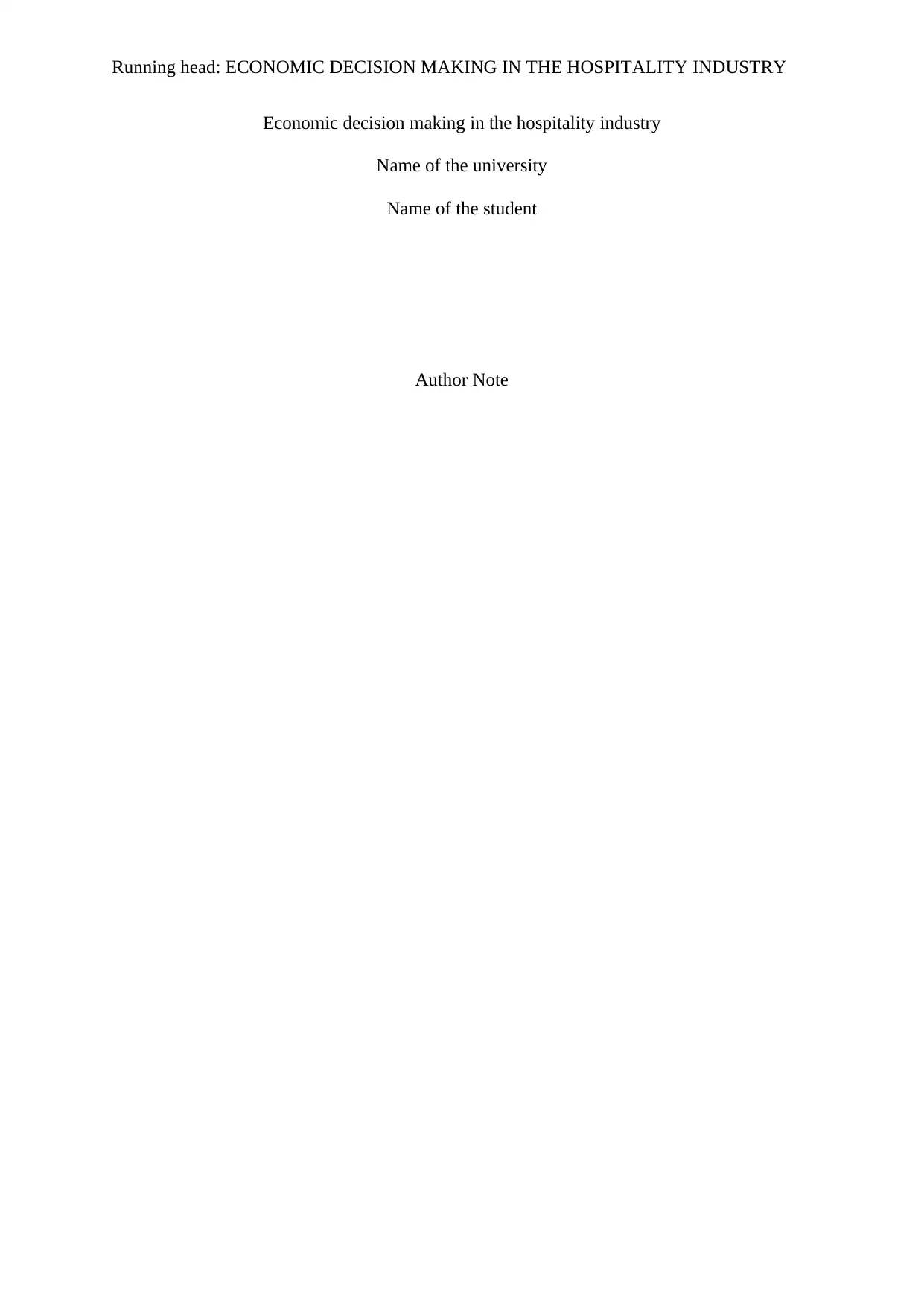
Running head: ECONOMIC DECISION MAKING IN THE HOSPITALITY INDUSTRY
Economic decision making in the hospitality industry
Name of the university
Name of the student
Author Note
Economic decision making in the hospitality industry
Name of the university
Name of the student
Author Note
Paraphrase This Document
Need a fresh take? Get an instant paraphrase of this document with our AI Paraphraser
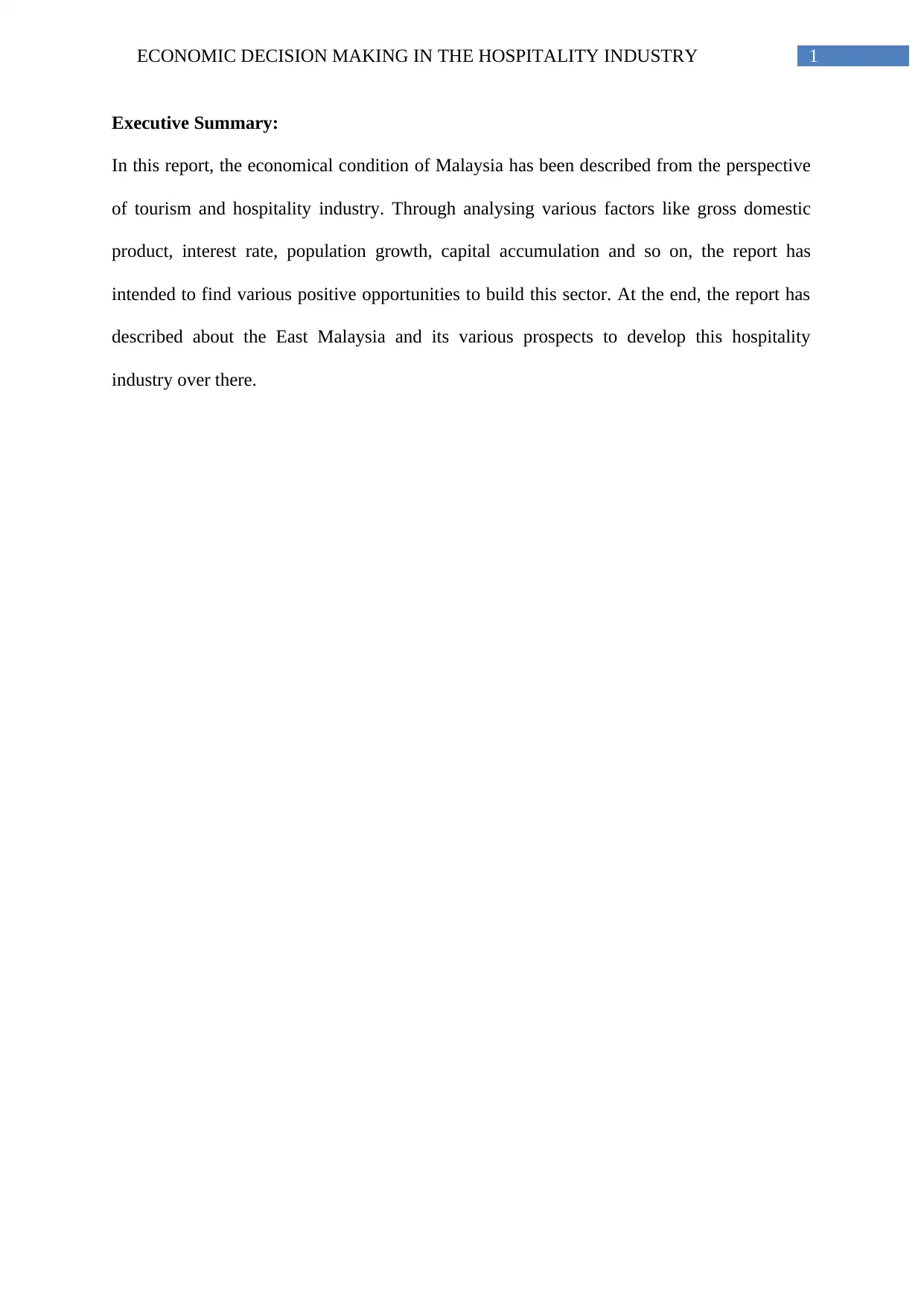
1ECONOMIC DECISION MAKING IN THE HOSPITALITY INDUSTRY
Executive Summary:
In this report, the economical condition of Malaysia has been described from the perspective
of tourism and hospitality industry. Through analysing various factors like gross domestic
product, interest rate, population growth, capital accumulation and so on, the report has
intended to find various positive opportunities to build this sector. At the end, the report has
described about the East Malaysia and its various prospects to develop this hospitality
industry over there.
Executive Summary:
In this report, the economical condition of Malaysia has been described from the perspective
of tourism and hospitality industry. Through analysing various factors like gross domestic
product, interest rate, population growth, capital accumulation and so on, the report has
intended to find various positive opportunities to build this sector. At the end, the report has
described about the East Malaysia and its various prospects to develop this hospitality
industry over there.
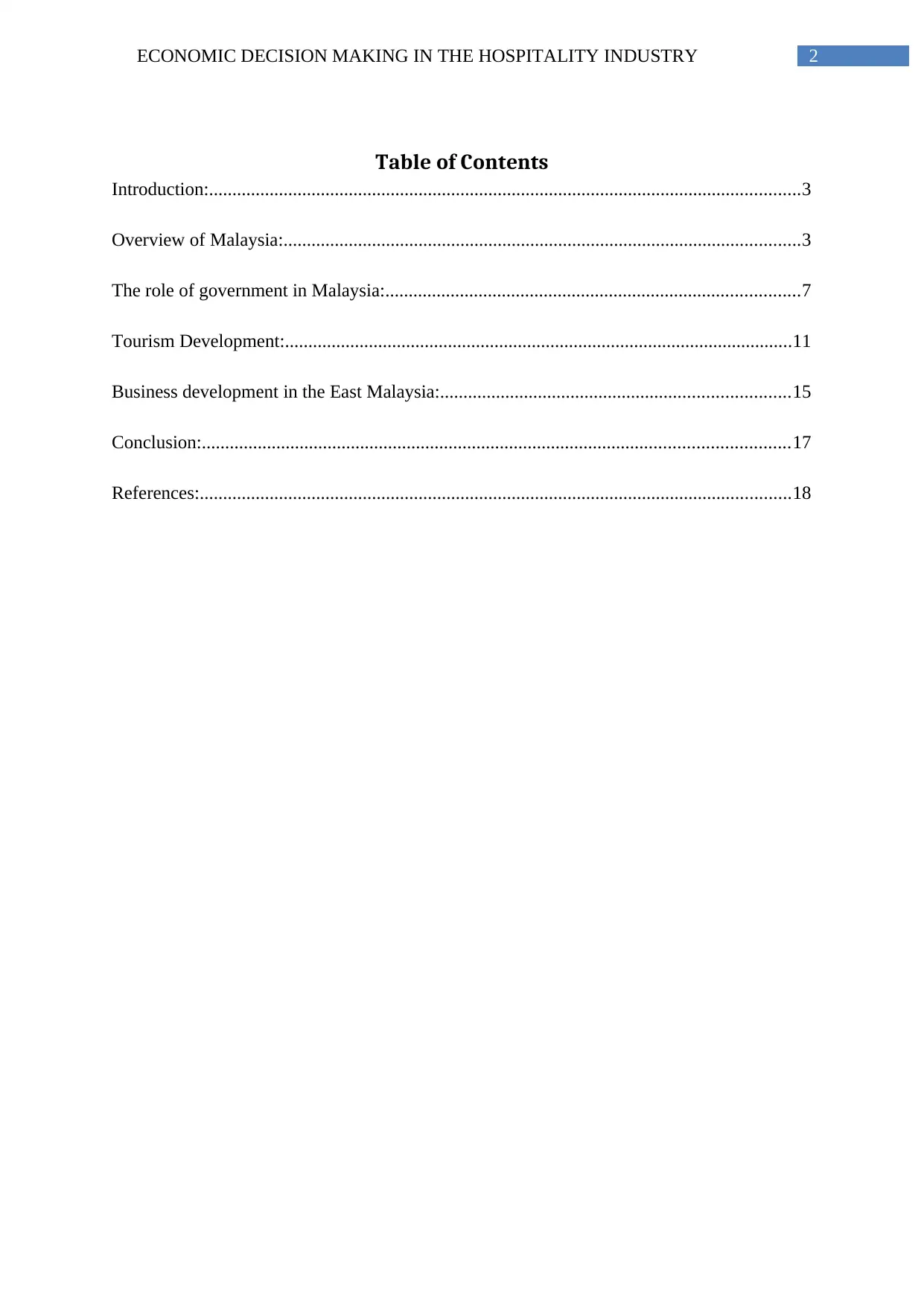
2ECONOMIC DECISION MAKING IN THE HOSPITALITY INDUSTRY
Table of Contents
Introduction:...............................................................................................................................3
Overview of Malaysia:...............................................................................................................3
The role of government in Malaysia:.........................................................................................7
Tourism Development:.............................................................................................................11
Business development in the East Malaysia:...........................................................................15
Conclusion:..............................................................................................................................17
References:...............................................................................................................................18
Table of Contents
Introduction:...............................................................................................................................3
Overview of Malaysia:...............................................................................................................3
The role of government in Malaysia:.........................................................................................7
Tourism Development:.............................................................................................................11
Business development in the East Malaysia:...........................................................................15
Conclusion:..............................................................................................................................17
References:...............................................................................................................................18
⊘ This is a preview!⊘
Do you want full access?
Subscribe today to unlock all pages.

Trusted by 1+ million students worldwide
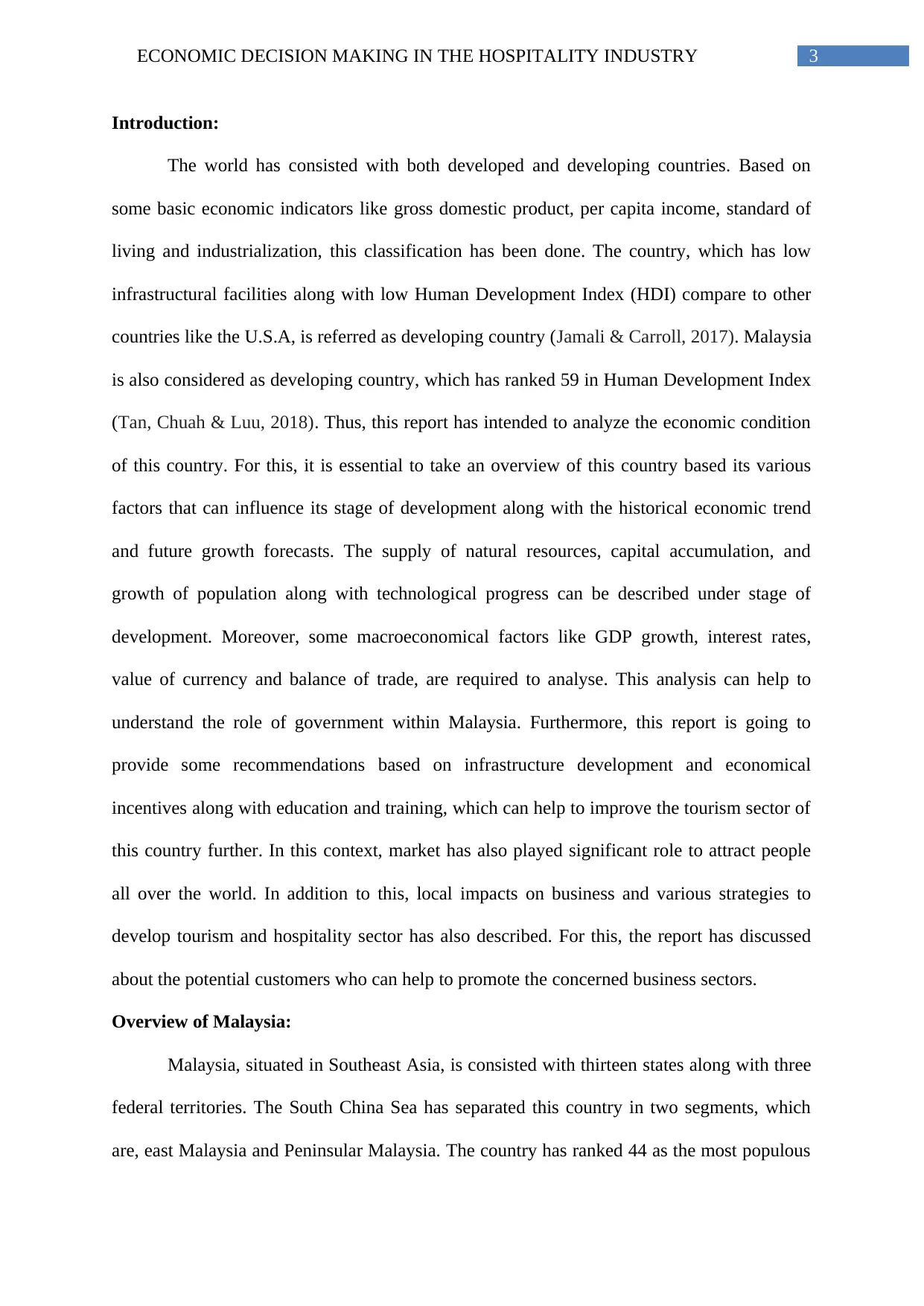
3ECONOMIC DECISION MAKING IN THE HOSPITALITY INDUSTRY
Introduction:
The world has consisted with both developed and developing countries. Based on
some basic economic indicators like gross domestic product, per capita income, standard of
living and industrialization, this classification has been done. The country, which has low
infrastructural facilities along with low Human Development Index (HDI) compare to other
countries like the U.S.A, is referred as developing country (Jamali & Carroll, 2017). Malaysia
is also considered as developing country, which has ranked 59 in Human Development Index
(Tan, Chuah & Luu, 2018). Thus, this report has intended to analyze the economic condition
of this country. For this, it is essential to take an overview of this country based its various
factors that can influence its stage of development along with the historical economic trend
and future growth forecasts. The supply of natural resources, capital accumulation, and
growth of population along with technological progress can be described under stage of
development. Moreover, some macroeconomical factors like GDP growth, interest rates,
value of currency and balance of trade, are required to analyse. This analysis can help to
understand the role of government within Malaysia. Furthermore, this report is going to
provide some recommendations based on infrastructure development and economical
incentives along with education and training, which can help to improve the tourism sector of
this country further. In this context, market has also played significant role to attract people
all over the world. In addition to this, local impacts on business and various strategies to
develop tourism and hospitality sector has also described. For this, the report has discussed
about the potential customers who can help to promote the concerned business sectors.
Overview of Malaysia:
Malaysia, situated in Southeast Asia, is consisted with thirteen states along with three
federal territories. The South China Sea has separated this country in two segments, which
are, east Malaysia and Peninsular Malaysia. The country has ranked 44 as the most populous
Introduction:
The world has consisted with both developed and developing countries. Based on
some basic economic indicators like gross domestic product, per capita income, standard of
living and industrialization, this classification has been done. The country, which has low
infrastructural facilities along with low Human Development Index (HDI) compare to other
countries like the U.S.A, is referred as developing country (Jamali & Carroll, 2017). Malaysia
is also considered as developing country, which has ranked 59 in Human Development Index
(Tan, Chuah & Luu, 2018). Thus, this report has intended to analyze the economic condition
of this country. For this, it is essential to take an overview of this country based its various
factors that can influence its stage of development along with the historical economic trend
and future growth forecasts. The supply of natural resources, capital accumulation, and
growth of population along with technological progress can be described under stage of
development. Moreover, some macroeconomical factors like GDP growth, interest rates,
value of currency and balance of trade, are required to analyse. This analysis can help to
understand the role of government within Malaysia. Furthermore, this report is going to
provide some recommendations based on infrastructure development and economical
incentives along with education and training, which can help to improve the tourism sector of
this country further. In this context, market has also played significant role to attract people
all over the world. In addition to this, local impacts on business and various strategies to
develop tourism and hospitality sector has also described. For this, the report has discussed
about the potential customers who can help to promote the concerned business sectors.
Overview of Malaysia:
Malaysia, situated in Southeast Asia, is consisted with thirteen states along with three
federal territories. The South China Sea has separated this country in two segments, which
are, east Malaysia and Peninsular Malaysia. The country has ranked 44 as the most populous
Paraphrase This Document
Need a fresh take? Get an instant paraphrase of this document with our AI Paraphraser
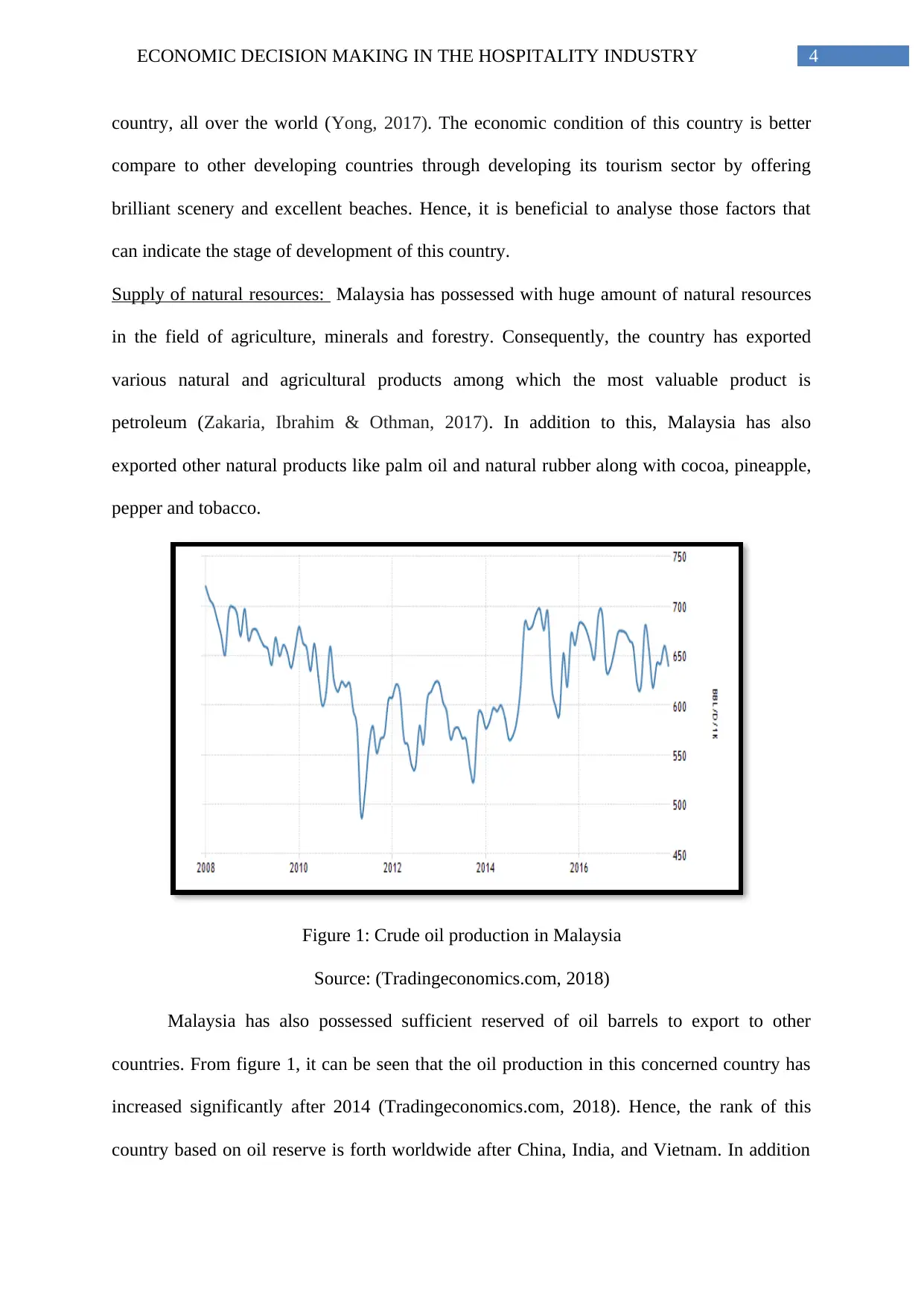
4ECONOMIC DECISION MAKING IN THE HOSPITALITY INDUSTRY
country, all over the world (Yong, 2017). The economic condition of this country is better
compare to other developing countries through developing its tourism sector by offering
brilliant scenery and excellent beaches. Hence, it is beneficial to analyse those factors that
can indicate the stage of development of this country.
Supply of natural resources: Malaysia has possessed with huge amount of natural resources
in the field of agriculture, minerals and forestry. Consequently, the country has exported
various natural and agricultural products among which the most valuable product is
petroleum (Zakaria, Ibrahim & Othman, 2017). In addition to this, Malaysia has also
exported other natural products like palm oil and natural rubber along with cocoa, pineapple,
pepper and tobacco.
Figure 1: Crude oil production in Malaysia
Source: (Tradingeconomics.com, 2018)
Malaysia has also possessed sufficient reserved of oil barrels to export to other
countries. From figure 1, it can be seen that the oil production in this concerned country has
increased significantly after 2014 (Tradingeconomics.com, 2018). Hence, the rank of this
country based on oil reserve is forth worldwide after China, India, and Vietnam. In addition
country, all over the world (Yong, 2017). The economic condition of this country is better
compare to other developing countries through developing its tourism sector by offering
brilliant scenery and excellent beaches. Hence, it is beneficial to analyse those factors that
can indicate the stage of development of this country.
Supply of natural resources: Malaysia has possessed with huge amount of natural resources
in the field of agriculture, minerals and forestry. Consequently, the country has exported
various natural and agricultural products among which the most valuable product is
petroleum (Zakaria, Ibrahim & Othman, 2017). In addition to this, Malaysia has also
exported other natural products like palm oil and natural rubber along with cocoa, pineapple,
pepper and tobacco.
Figure 1: Crude oil production in Malaysia
Source: (Tradingeconomics.com, 2018)
Malaysia has also possessed sufficient reserved of oil barrels to export to other
countries. From figure 1, it can be seen that the oil production in this concerned country has
increased significantly after 2014 (Tradingeconomics.com, 2018). Hence, the rank of this
country based on oil reserve is forth worldwide after China, India, and Vietnam. In addition
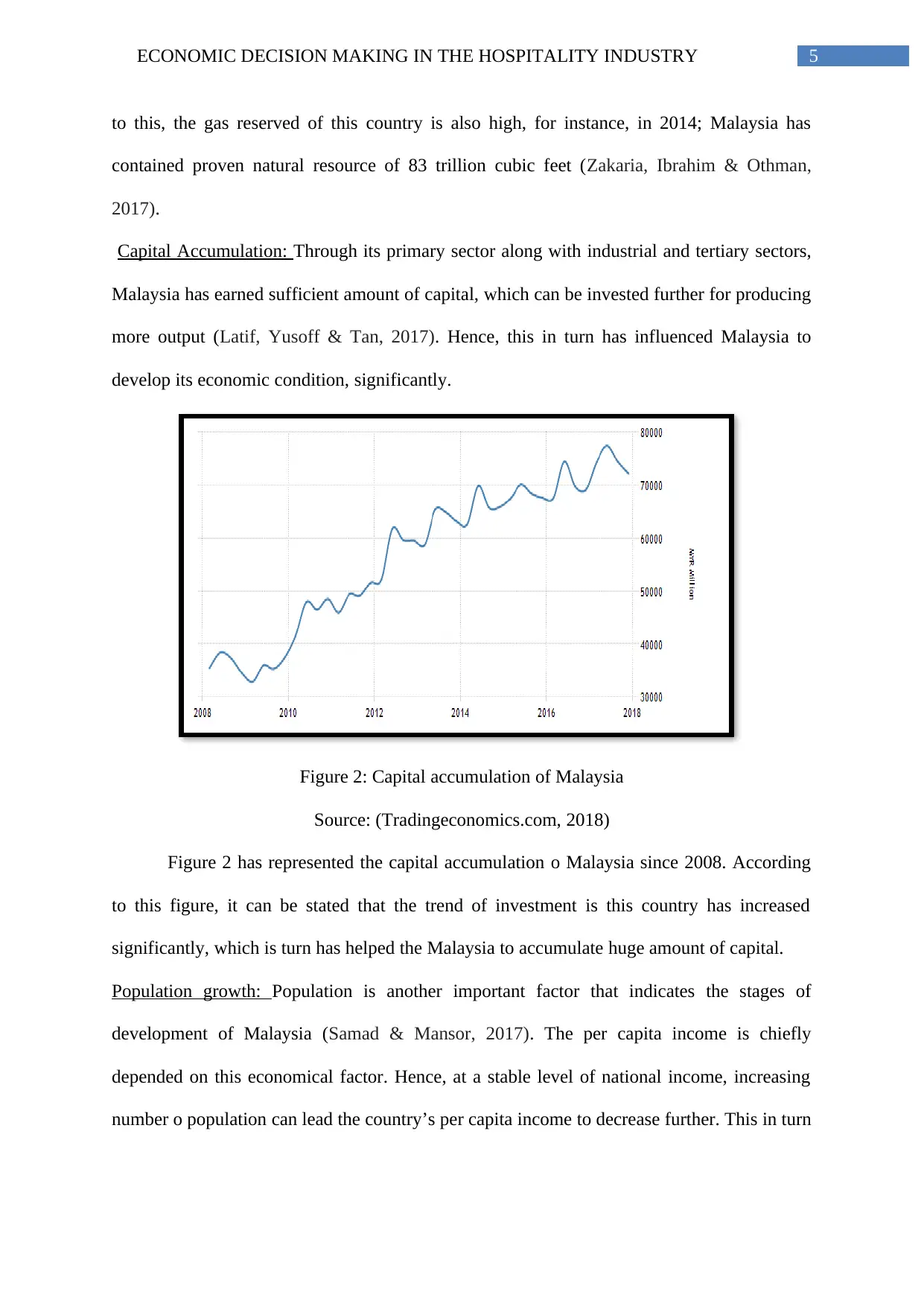
5ECONOMIC DECISION MAKING IN THE HOSPITALITY INDUSTRY
to this, the gas reserved of this country is also high, for instance, in 2014; Malaysia has
contained proven natural resource of 83 trillion cubic feet (Zakaria, Ibrahim & Othman,
2017).
Capital Accumulation: Through its primary sector along with industrial and tertiary sectors,
Malaysia has earned sufficient amount of capital, which can be invested further for producing
more output (Latif, Yusoff & Tan, 2017). Hence, this in turn has influenced Malaysia to
develop its economic condition, significantly.
Figure 2: Capital accumulation of Malaysia
Source: (Tradingeconomics.com, 2018)
Figure 2 has represented the capital accumulation o Malaysia since 2008. According
to this figure, it can be stated that the trend of investment is this country has increased
significantly, which is turn has helped the Malaysia to accumulate huge amount of capital.
Population growth: Population is another important factor that indicates the stages of
development of Malaysia (Samad & Mansor, 2017). The per capita income is chiefly
depended on this economical factor. Hence, at a stable level of national income, increasing
number o population can lead the country’s per capita income to decrease further. This in turn
to this, the gas reserved of this country is also high, for instance, in 2014; Malaysia has
contained proven natural resource of 83 trillion cubic feet (Zakaria, Ibrahim & Othman,
2017).
Capital Accumulation: Through its primary sector along with industrial and tertiary sectors,
Malaysia has earned sufficient amount of capital, which can be invested further for producing
more output (Latif, Yusoff & Tan, 2017). Hence, this in turn has influenced Malaysia to
develop its economic condition, significantly.
Figure 2: Capital accumulation of Malaysia
Source: (Tradingeconomics.com, 2018)
Figure 2 has represented the capital accumulation o Malaysia since 2008. According
to this figure, it can be stated that the trend of investment is this country has increased
significantly, which is turn has helped the Malaysia to accumulate huge amount of capital.
Population growth: Population is another important factor that indicates the stages of
development of Malaysia (Samad & Mansor, 2017). The per capita income is chiefly
depended on this economical factor. Hence, at a stable level of national income, increasing
number o population can lead the country’s per capita income to decrease further. This in turn
⊘ This is a preview!⊘
Do you want full access?
Subscribe today to unlock all pages.

Trusted by 1+ million students worldwide
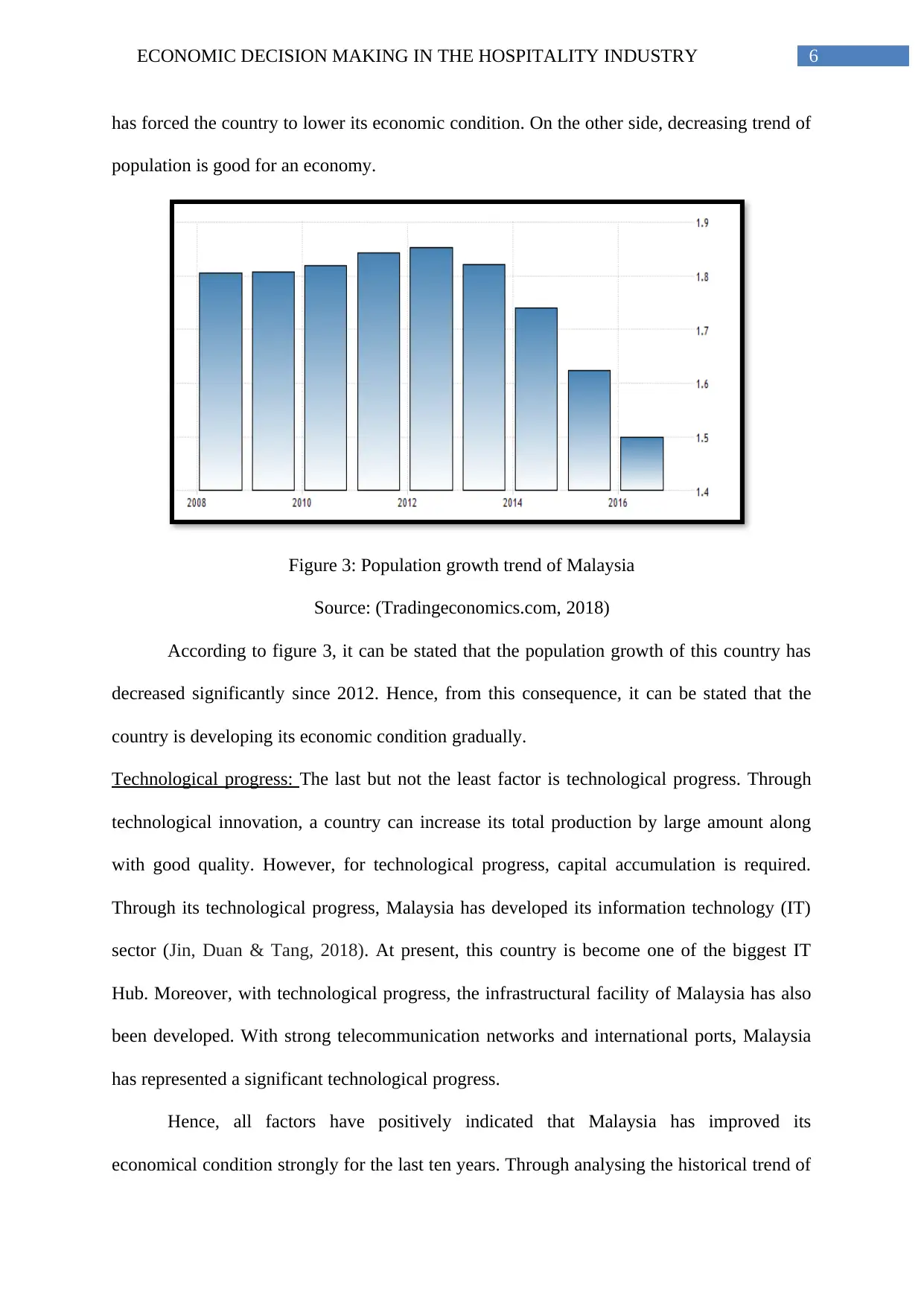
6ECONOMIC DECISION MAKING IN THE HOSPITALITY INDUSTRY
has forced the country to lower its economic condition. On the other side, decreasing trend of
population is good for an economy.
Figure 3: Population growth trend of Malaysia
Source: (Tradingeconomics.com, 2018)
According to figure 3, it can be stated that the population growth of this country has
decreased significantly since 2012. Hence, from this consequence, it can be stated that the
country is developing its economic condition gradually.
Technological progress: The last but not the least factor is technological progress. Through
technological innovation, a country can increase its total production by large amount along
with good quality. However, for technological progress, capital accumulation is required.
Through its technological progress, Malaysia has developed its information technology (IT)
sector (Jin, Duan & Tang, 2018). At present, this country is become one of the biggest IT
Hub. Moreover, with technological progress, the infrastructural facility of Malaysia has also
been developed. With strong telecommunication networks and international ports, Malaysia
has represented a significant technological progress.
Hence, all factors have positively indicated that Malaysia has improved its
economical condition strongly for the last ten years. Through analysing the historical trend of
has forced the country to lower its economic condition. On the other side, decreasing trend of
population is good for an economy.
Figure 3: Population growth trend of Malaysia
Source: (Tradingeconomics.com, 2018)
According to figure 3, it can be stated that the population growth of this country has
decreased significantly since 2012. Hence, from this consequence, it can be stated that the
country is developing its economic condition gradually.
Technological progress: The last but not the least factor is technological progress. Through
technological innovation, a country can increase its total production by large amount along
with good quality. However, for technological progress, capital accumulation is required.
Through its technological progress, Malaysia has developed its information technology (IT)
sector (Jin, Duan & Tang, 2018). At present, this country is become one of the biggest IT
Hub. Moreover, with technological progress, the infrastructural facility of Malaysia has also
been developed. With strong telecommunication networks and international ports, Malaysia
has represented a significant technological progress.
Hence, all factors have positively indicated that Malaysia has improved its
economical condition strongly for the last ten years. Through analysing the historical trend of
Paraphrase This Document
Need a fresh take? Get an instant paraphrase of this document with our AI Paraphraser
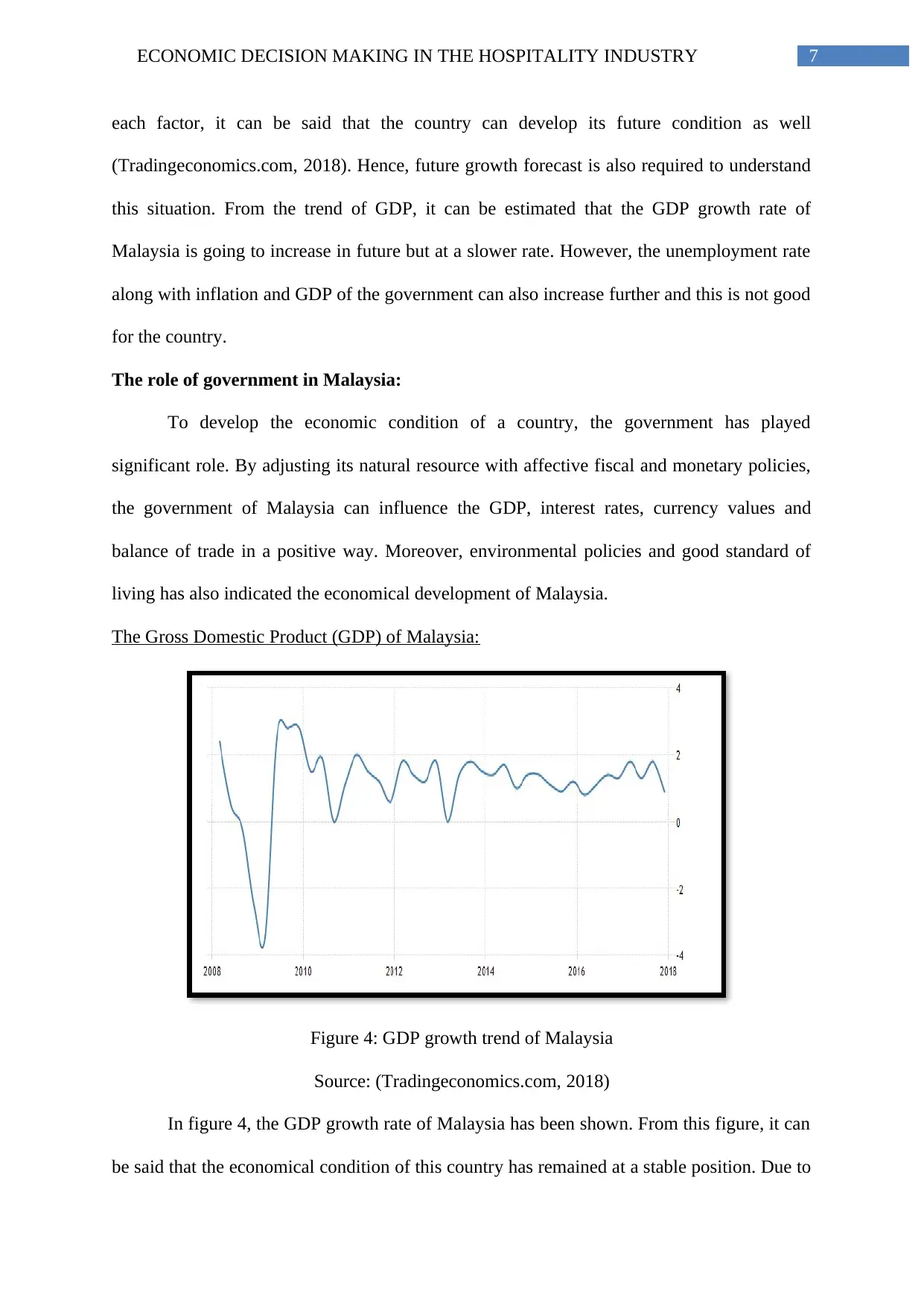
7ECONOMIC DECISION MAKING IN THE HOSPITALITY INDUSTRY
each factor, it can be said that the country can develop its future condition as well
(Tradingeconomics.com, 2018). Hence, future growth forecast is also required to understand
this situation. From the trend of GDP, it can be estimated that the GDP growth rate of
Malaysia is going to increase in future but at a slower rate. However, the unemployment rate
along with inflation and GDP of the government can also increase further and this is not good
for the country.
The role of government in Malaysia:
To develop the economic condition of a country, the government has played
significant role. By adjusting its natural resource with affective fiscal and monetary policies,
the government of Malaysia can influence the GDP, interest rates, currency values and
balance of trade in a positive way. Moreover, environmental policies and good standard of
living has also indicated the economical development of Malaysia.
The Gross Domestic Product (GDP) of Malaysia:
Figure 4: GDP growth trend of Malaysia
Source: (Tradingeconomics.com, 2018)
In figure 4, the GDP growth rate of Malaysia has been shown. From this figure, it can
be said that the economical condition of this country has remained at a stable position. Due to
each factor, it can be said that the country can develop its future condition as well
(Tradingeconomics.com, 2018). Hence, future growth forecast is also required to understand
this situation. From the trend of GDP, it can be estimated that the GDP growth rate of
Malaysia is going to increase in future but at a slower rate. However, the unemployment rate
along with inflation and GDP of the government can also increase further and this is not good
for the country.
The role of government in Malaysia:
To develop the economic condition of a country, the government has played
significant role. By adjusting its natural resource with affective fiscal and monetary policies,
the government of Malaysia can influence the GDP, interest rates, currency values and
balance of trade in a positive way. Moreover, environmental policies and good standard of
living has also indicated the economical development of Malaysia.
The Gross Domestic Product (GDP) of Malaysia:
Figure 4: GDP growth trend of Malaysia
Source: (Tradingeconomics.com, 2018)
In figure 4, the GDP growth rate of Malaysia has been shown. From this figure, it can
be said that the economical condition of this country has remained at a stable position. Due to
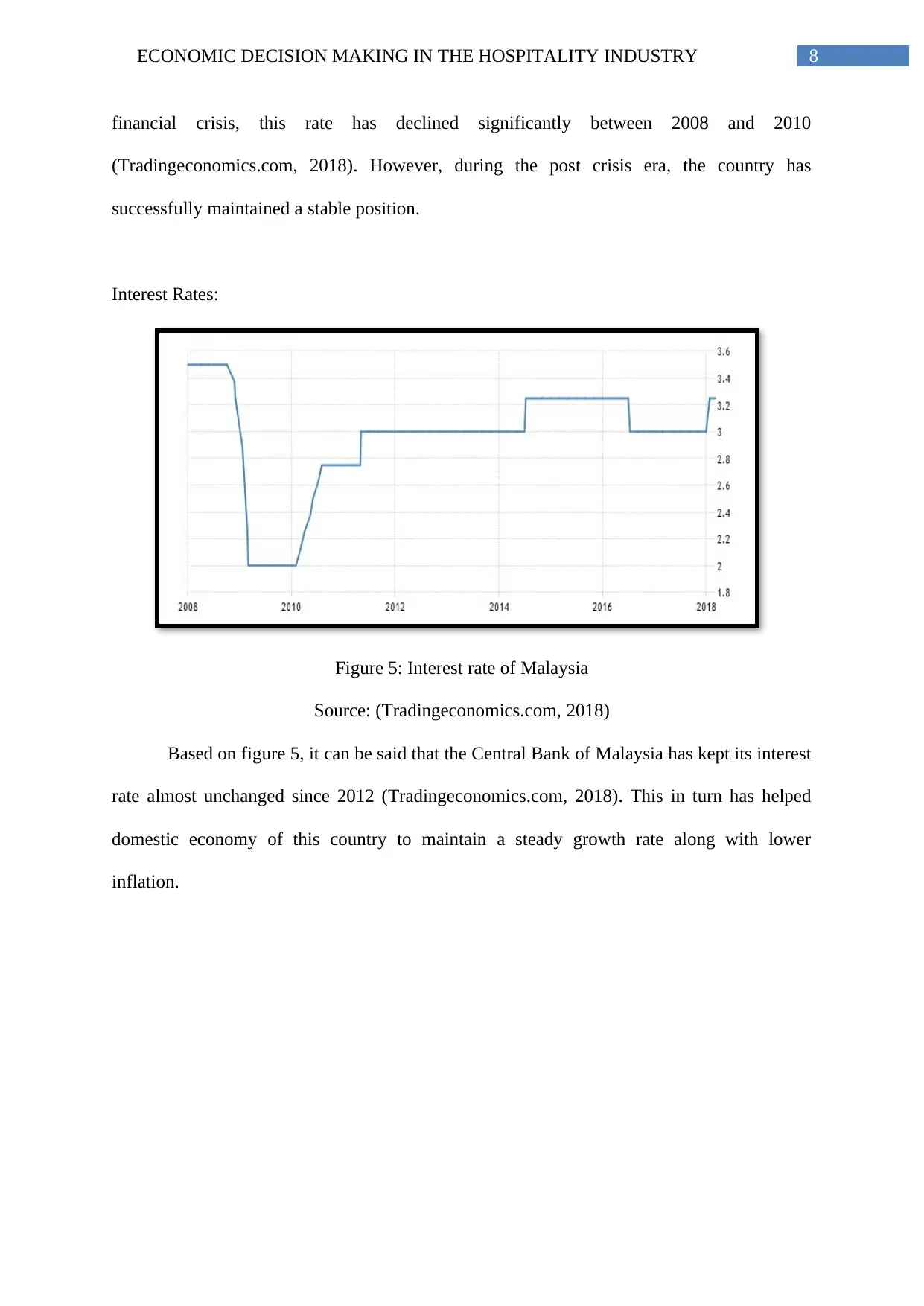
8ECONOMIC DECISION MAKING IN THE HOSPITALITY INDUSTRY
financial crisis, this rate has declined significantly between 2008 and 2010
(Tradingeconomics.com, 2018). However, during the post crisis era, the country has
successfully maintained a stable position.
Interest Rates:
Figure 5: Interest rate of Malaysia
Source: (Tradingeconomics.com, 2018)
Based on figure 5, it can be said that the Central Bank of Malaysia has kept its interest
rate almost unchanged since 2012 (Tradingeconomics.com, 2018). This in turn has helped
domestic economy of this country to maintain a steady growth rate along with lower
inflation.
financial crisis, this rate has declined significantly between 2008 and 2010
(Tradingeconomics.com, 2018). However, during the post crisis era, the country has
successfully maintained a stable position.
Interest Rates:
Figure 5: Interest rate of Malaysia
Source: (Tradingeconomics.com, 2018)
Based on figure 5, it can be said that the Central Bank of Malaysia has kept its interest
rate almost unchanged since 2012 (Tradingeconomics.com, 2018). This in turn has helped
domestic economy of this country to maintain a steady growth rate along with lower
inflation.
⊘ This is a preview!⊘
Do you want full access?
Subscribe today to unlock all pages.

Trusted by 1+ million students worldwide
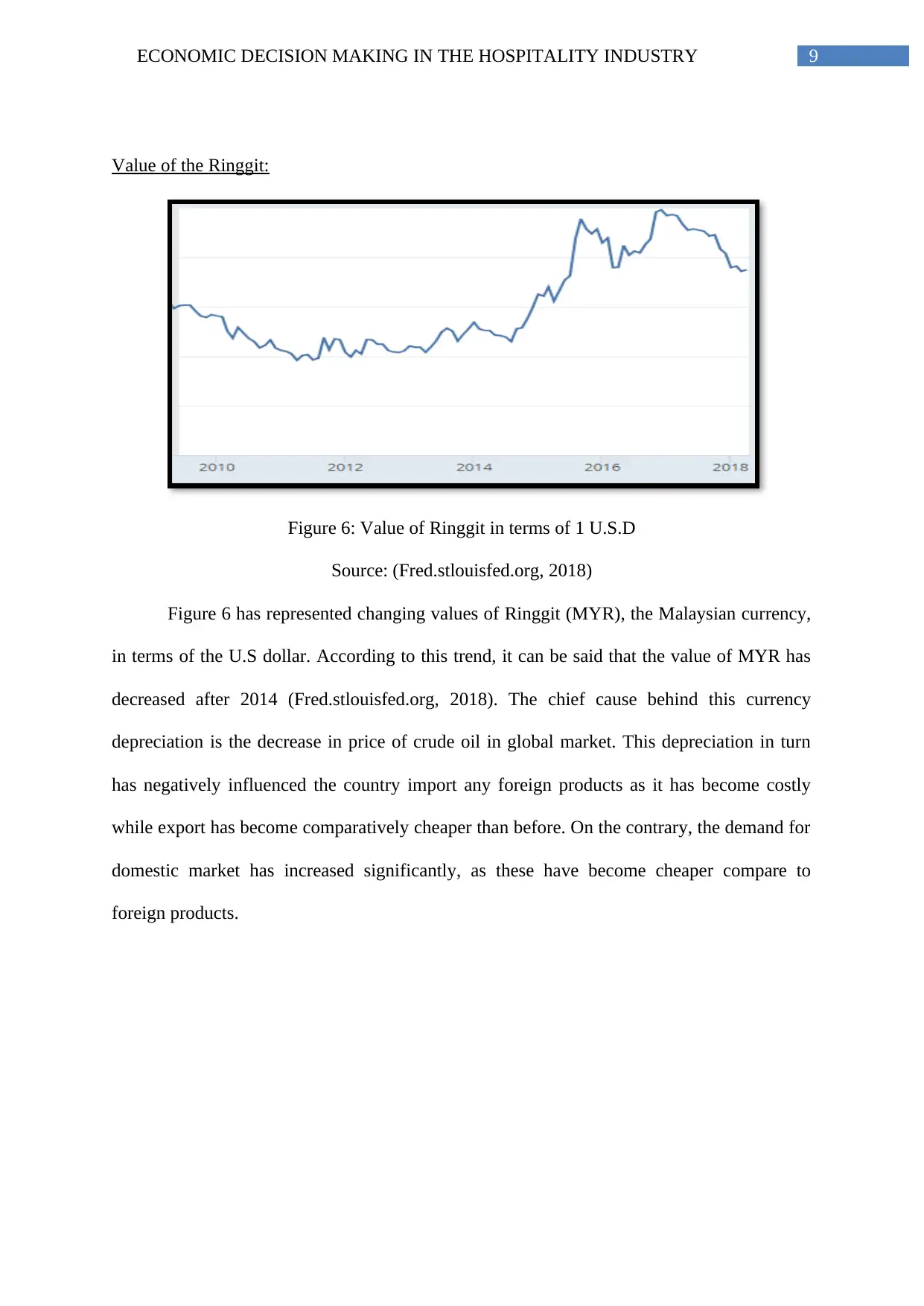
9ECONOMIC DECISION MAKING IN THE HOSPITALITY INDUSTRY
Value of the Ringgit:
Figure 6: Value of Ringgit in terms of 1 U.S.D
Source: (Fred.stlouisfed.org, 2018)
Figure 6 has represented changing values of Ringgit (MYR), the Malaysian currency,
in terms of the U.S dollar. According to this trend, it can be said that the value of MYR has
decreased after 2014 (Fred.stlouisfed.org, 2018). The chief cause behind this currency
depreciation is the decrease in price of crude oil in global market. This depreciation in turn
has negatively influenced the country import any foreign products as it has become costly
while export has become comparatively cheaper than before. On the contrary, the demand for
domestic market has increased significantly, as these have become cheaper compare to
foreign products.
Value of the Ringgit:
Figure 6: Value of Ringgit in terms of 1 U.S.D
Source: (Fred.stlouisfed.org, 2018)
Figure 6 has represented changing values of Ringgit (MYR), the Malaysian currency,
in terms of the U.S dollar. According to this trend, it can be said that the value of MYR has
decreased after 2014 (Fred.stlouisfed.org, 2018). The chief cause behind this currency
depreciation is the decrease in price of crude oil in global market. This depreciation in turn
has negatively influenced the country import any foreign products as it has become costly
while export has become comparatively cheaper than before. On the contrary, the demand for
domestic market has increased significantly, as these have become cheaper compare to
foreign products.
Paraphrase This Document
Need a fresh take? Get an instant paraphrase of this document with our AI Paraphraser
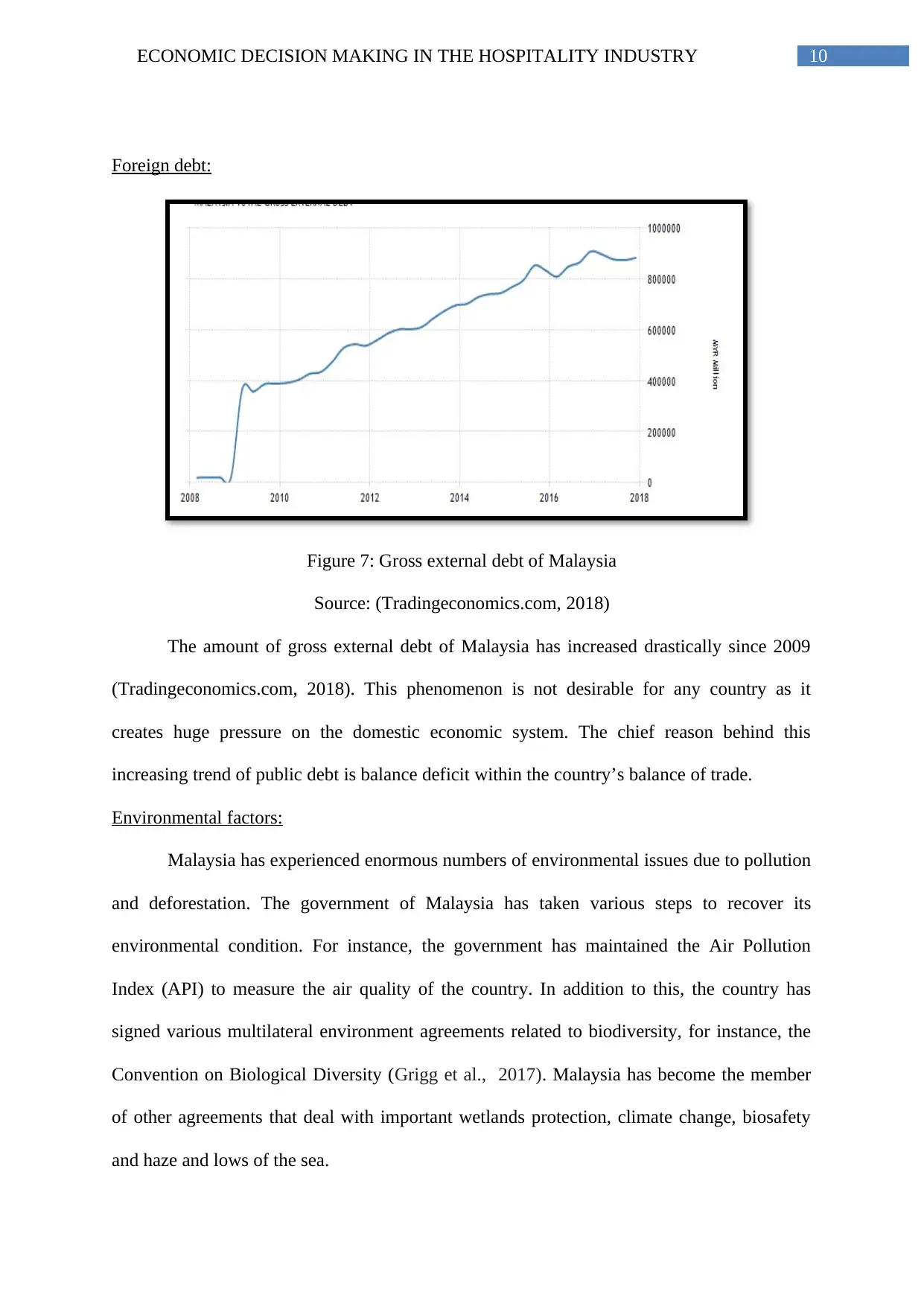
10ECONOMIC DECISION MAKING IN THE HOSPITALITY INDUSTRY
Foreign debt:
Figure 7: Gross external debt of Malaysia
Source: (Tradingeconomics.com, 2018)
The amount of gross external debt of Malaysia has increased drastically since 2009
(Tradingeconomics.com, 2018). This phenomenon is not desirable for any country as it
creates huge pressure on the domestic economic system. The chief reason behind this
increasing trend of public debt is balance deficit within the country’s balance of trade.
Environmental factors:
Malaysia has experienced enormous numbers of environmental issues due to pollution
and deforestation. The government of Malaysia has taken various steps to recover its
environmental condition. For instance, the government has maintained the Air Pollution
Index (API) to measure the air quality of the country. In addition to this, the country has
signed various multilateral environment agreements related to biodiversity, for instance, the
Convention on Biological Diversity (Grigg et al., 2017). Malaysia has become the member
of other agreements that deal with important wetlands protection, climate change, biosafety
and haze and lows of the sea.
Foreign debt:
Figure 7: Gross external debt of Malaysia
Source: (Tradingeconomics.com, 2018)
The amount of gross external debt of Malaysia has increased drastically since 2009
(Tradingeconomics.com, 2018). This phenomenon is not desirable for any country as it
creates huge pressure on the domestic economic system. The chief reason behind this
increasing trend of public debt is balance deficit within the country’s balance of trade.
Environmental factors:
Malaysia has experienced enormous numbers of environmental issues due to pollution
and deforestation. The government of Malaysia has taken various steps to recover its
environmental condition. For instance, the government has maintained the Air Pollution
Index (API) to measure the air quality of the country. In addition to this, the country has
signed various multilateral environment agreements related to biodiversity, for instance, the
Convention on Biological Diversity (Grigg et al., 2017). Malaysia has become the member
of other agreements that deal with important wetlands protection, climate change, biosafety
and haze and lows of the sea.
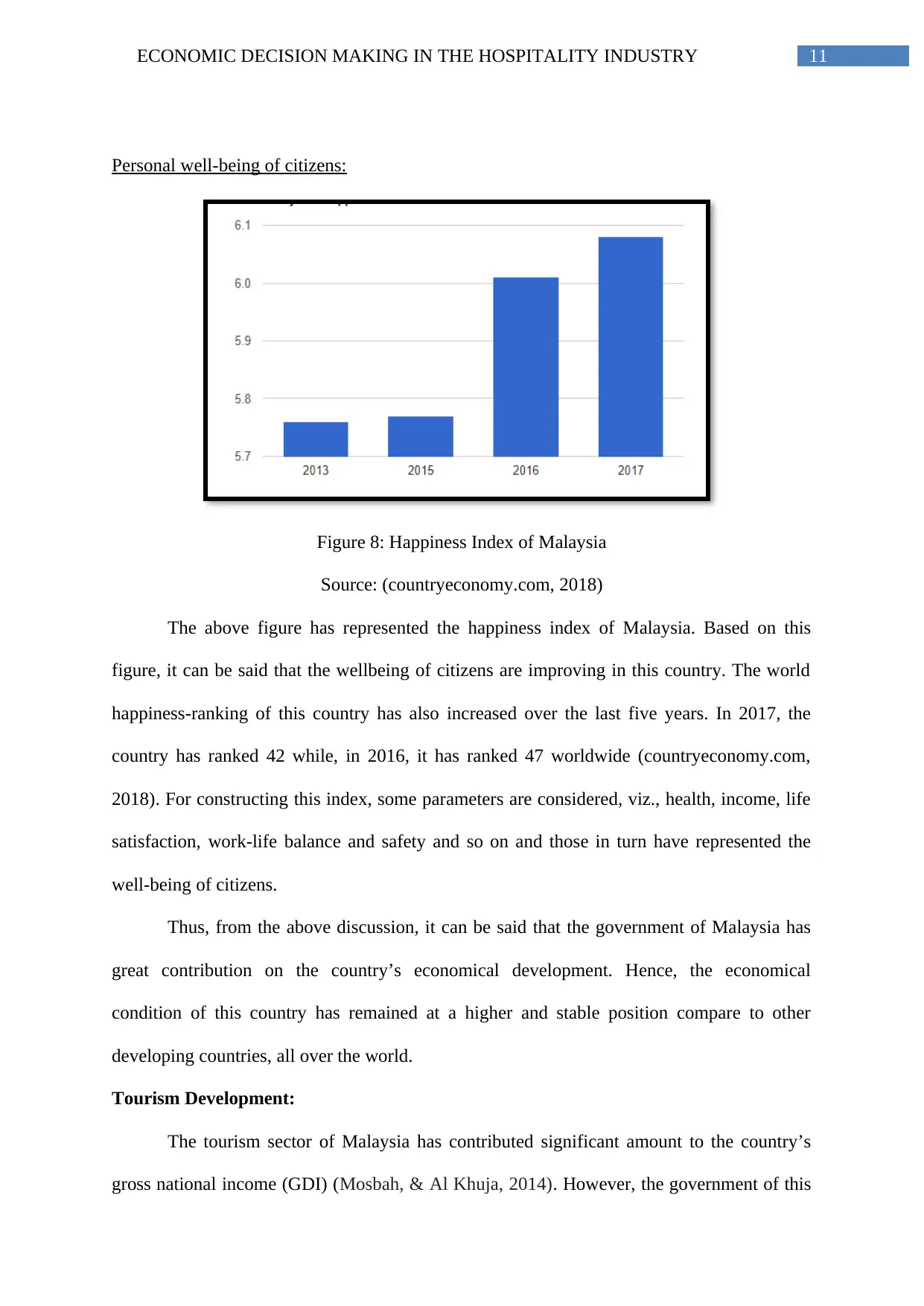
11ECONOMIC DECISION MAKING IN THE HOSPITALITY INDUSTRY
Personal well-being of citizens:
Figure 8: Happiness Index of Malaysia
Source: (countryeconomy.com, 2018)
The above figure has represented the happiness index of Malaysia. Based on this
figure, it can be said that the wellbeing of citizens are improving in this country. The world
happiness-ranking of this country has also increased over the last five years. In 2017, the
country has ranked 42 while, in 2016, it has ranked 47 worldwide (countryeconomy.com,
2018). For constructing this index, some parameters are considered, viz., health, income, life
satisfaction, work-life balance and safety and so on and those in turn have represented the
well-being of citizens.
Thus, from the above discussion, it can be said that the government of Malaysia has
great contribution on the country’s economical development. Hence, the economical
condition of this country has remained at a higher and stable position compare to other
developing countries, all over the world.
Tourism Development:
The tourism sector of Malaysia has contributed significant amount to the country’s
gross national income (GDI) (Mosbah, & Al Khuja, 2014). However, the government of this
Personal well-being of citizens:
Figure 8: Happiness Index of Malaysia
Source: (countryeconomy.com, 2018)
The above figure has represented the happiness index of Malaysia. Based on this
figure, it can be said that the wellbeing of citizens are improving in this country. The world
happiness-ranking of this country has also increased over the last five years. In 2017, the
country has ranked 42 while, in 2016, it has ranked 47 worldwide (countryeconomy.com,
2018). For constructing this index, some parameters are considered, viz., health, income, life
satisfaction, work-life balance and safety and so on and those in turn have represented the
well-being of citizens.
Thus, from the above discussion, it can be said that the government of Malaysia has
great contribution on the country’s economical development. Hence, the economical
condition of this country has remained at a higher and stable position compare to other
developing countries, all over the world.
Tourism Development:
The tourism sector of Malaysia has contributed significant amount to the country’s
gross national income (GDI) (Mosbah, & Al Khuja, 2014). However, the government of this
⊘ This is a preview!⊘
Do you want full access?
Subscribe today to unlock all pages.

Trusted by 1+ million students worldwide
1 out of 22
Related Documents
Your All-in-One AI-Powered Toolkit for Academic Success.
+13062052269
info@desklib.com
Available 24*7 on WhatsApp / Email
![[object Object]](/_next/static/media/star-bottom.7253800d.svg)
Unlock your academic potential
Copyright © 2020–2025 A2Z Services. All Rights Reserved. Developed and managed by ZUCOL.





